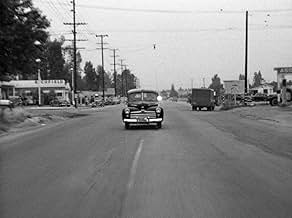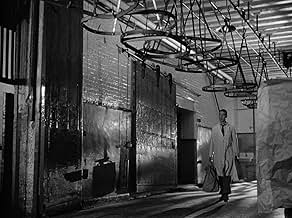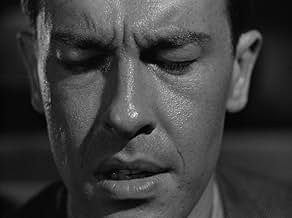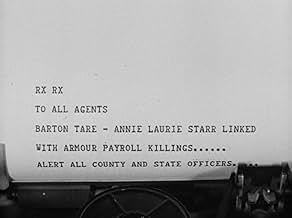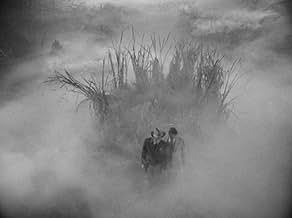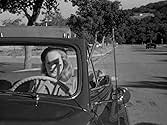CALIFICACIÓN DE IMDb
7.6/10
16 k
TU CALIFICACIÓN
Un marido con buenas intenciones es presionado por su bella esposa para participar en un robo interestatal, donde descubre cuán depravada y mortal es realmente.Un marido con buenas intenciones es presionado por su bella esposa para participar en un robo interestatal, donde descubre cuán depravada y mortal es realmente.Un marido con buenas intenciones es presionado por su bella esposa para participar en un robo interestatal, donde descubre cuán depravada y mortal es realmente.
- Dirección
- Guionistas
- Elenco
- Premios
- 1 premio ganado en total
Russ Tamblyn
- Bart Tare (age 14)
- (as Rusty Tamblyn)
David Bair
- Dave Allister (child)
- (as Dave Bair)
Frances Irvin
- Danceland Singer
- (as Frances Irwin)
Opiniones destacadas
No need to echo consensus points or plot details after a hundred or so reviews.
Yes indeed, much has been written about Lewis's little gem and deservedly so. What I get from it is how trapped Bart (Dall) is by forces he neither understands nor controls, until it's too late. On one hand there's Annie Laurie Starr (Cummins) whose raw sexuality is about as subtle as Mae West on aphrodisiacs. On the other, is Bart's natural talent with guns, the only thing he professes to be good at. So when the camera pans up from Laurie's thighs to the twirling six-shooters in the carny sideshow, Bart's in some kind of NRA heaven.
Then after he shoots out her last flame to show who's gun boss, their betrothal is sealed. At this point, they could retire to a Remington plant somewhere to live out conventional lives, except for one problem--- Laurie gets turned on by violence, especially with a revolver, while Bart's a converted pacifist, allergic to killing anything. So the problem is if Bart wants some of Laurie's white-hot sex, he's got to collaborate on her life of crime. Poor Bart, he'd like to be just another married couple, but temptress Laurie is just too much for his confusion. Plus, it's not a ring that bonds them, it's two clutching hands on a revolver that seals their love. For Bart, it's a spell he can't break until the mist finally swallows them both.
No doubt about it, Lewis has concocted a visual masterpiece that frames the story perfectly. However, I'm still wondering how Bart can shoot out a cop's tire through a glass pane without breaking it. Oh well, no movie's perfect.
Yes indeed, much has been written about Lewis's little gem and deservedly so. What I get from it is how trapped Bart (Dall) is by forces he neither understands nor controls, until it's too late. On one hand there's Annie Laurie Starr (Cummins) whose raw sexuality is about as subtle as Mae West on aphrodisiacs. On the other, is Bart's natural talent with guns, the only thing he professes to be good at. So when the camera pans up from Laurie's thighs to the twirling six-shooters in the carny sideshow, Bart's in some kind of NRA heaven.
Then after he shoots out her last flame to show who's gun boss, their betrothal is sealed. At this point, they could retire to a Remington plant somewhere to live out conventional lives, except for one problem--- Laurie gets turned on by violence, especially with a revolver, while Bart's a converted pacifist, allergic to killing anything. So the problem is if Bart wants some of Laurie's white-hot sex, he's got to collaborate on her life of crime. Poor Bart, he'd like to be just another married couple, but temptress Laurie is just too much for his confusion. Plus, it's not a ring that bonds them, it's two clutching hands on a revolver that seals their love. For Bart, it's a spell he can't break until the mist finally swallows them both.
No doubt about it, Lewis has concocted a visual masterpiece that frames the story perfectly. However, I'm still wondering how Bart can shoot out a cop's tire through a glass pane without breaking it. Oh well, no movie's perfect.
The original title of "Gun Crazy" was "Deadly Is the Female," and they ain't kidding. If you thought Faye Dunaway's Bonnie Parker was the more ruthless member of the crime duo that gave Arthur Penn's 1967 film its name, wait till you get a load of Peggy Cummins's Annie in this little known cheapie from 1949. I wouldn't want to get on this woman's bad side; she can shoot cigarettes out of people's mouths, for God's sake.
"Gun Crazy" is such an obvious influence on Penn's "Bonnie and Clyde" that I can't believe the later film doesn't credit it directly. Though the 1949 film is based on a short story that appeared in the "Saturday Evening Post" and the 1967 film worked with an original screenplay, both films could have been adapted from the same source. They portray the Annie/Bonnie character as bored and restless, turned on by the thought of crime and by a manly man who can really use his "gun." The Bart/Clyde character is tickled by the idea of being a virile stud in the eyes of his lover, but is ultimately too sensitive for the life they choose. And both films do a good job of portraying the desperation that plagues both couples, the isolation and loneliness they create for themselves and can never break out of, and the ultimate futility of their actions, since the "law" is going to catch up with them sooner or later.
Peggy Cummins is really good in this. I don't know what else she's been in, but her baby-doll voice creates an effective contrast to her colder-than-ice attitude. She's crooning into her lover's ear one minute and itching to kill someone the next. And you have to dig those French-inspired fashions that would cause a sensation nearly 20 years later when Dunaway donned them again for Penn's film.
I thought John Dall was at first odd casting for the role of Bart. Annie is supposed to think of him as a man's man, and Dall, with his willowy physique and gentle mannerisms is far from that. But then when we realize that he's at heart really too gentle for the life he and Annie have chosen for themselves, his casting makes sense.
There are some small touches to this film that really add to its immediacy and realism. I loved the scenes of Annie and Bart driving to and from their heist jobs, shot from the back seat of the car as if we are a member of their gang. They have really funny and natural banter back and forth about where to park, etc. which I have to believe was improvised to some extent. The ending of the film, a face off in a creepy swamp, is eerie, and there's a small twist in the last seconds of the film that might be easy to miss but may give you some things to think about if you catch it.
It's interesting, and rather depressing, that one of the main themes of this film is the obsession with guns and violence that pervaded the country nearly 60 years ago, and here we are a handful of wars later, still dragging around the same old obsessions. Michael Moore's recent documentary "Bowling for Columbine" could have just as easily been called "Gun Crazy," if that title weren't already taken by this forgotten little blast of a movie.
Grade: A-
"Gun Crazy" is such an obvious influence on Penn's "Bonnie and Clyde" that I can't believe the later film doesn't credit it directly. Though the 1949 film is based on a short story that appeared in the "Saturday Evening Post" and the 1967 film worked with an original screenplay, both films could have been adapted from the same source. They portray the Annie/Bonnie character as bored and restless, turned on by the thought of crime and by a manly man who can really use his "gun." The Bart/Clyde character is tickled by the idea of being a virile stud in the eyes of his lover, but is ultimately too sensitive for the life they choose. And both films do a good job of portraying the desperation that plagues both couples, the isolation and loneliness they create for themselves and can never break out of, and the ultimate futility of their actions, since the "law" is going to catch up with them sooner or later.
Peggy Cummins is really good in this. I don't know what else she's been in, but her baby-doll voice creates an effective contrast to her colder-than-ice attitude. She's crooning into her lover's ear one minute and itching to kill someone the next. And you have to dig those French-inspired fashions that would cause a sensation nearly 20 years later when Dunaway donned them again for Penn's film.
I thought John Dall was at first odd casting for the role of Bart. Annie is supposed to think of him as a man's man, and Dall, with his willowy physique and gentle mannerisms is far from that. But then when we realize that he's at heart really too gentle for the life he and Annie have chosen for themselves, his casting makes sense.
There are some small touches to this film that really add to its immediacy and realism. I loved the scenes of Annie and Bart driving to and from their heist jobs, shot from the back seat of the car as if we are a member of their gang. They have really funny and natural banter back and forth about where to park, etc. which I have to believe was improvised to some extent. The ending of the film, a face off in a creepy swamp, is eerie, and there's a small twist in the last seconds of the film that might be easy to miss but may give you some things to think about if you catch it.
It's interesting, and rather depressing, that one of the main themes of this film is the obsession with guns and violence that pervaded the country nearly 60 years ago, and here we are a handful of wars later, still dragging around the same old obsessions. Michael Moore's recent documentary "Bowling for Columbine" could have just as easily been called "Gun Crazy," if that title weren't already taken by this forgotten little blast of a movie.
Grade: A-
I have long been a fan of Film Noir. I consider this film to be unique and one of the best. The first and only time I saw it in a theater was in 1949 when I was 14. It was titled "Gun Crazy". I thought it was great but it didn't receive rave reviews or last long in hometown theaters. I understand they renamed it "Deadly Is The Female" in 1950 for its release in England, reason being that co-star Peggy Cummins was British and emphasizing the female star would be better box-office.
In the years that passed I wanted to see it again but it didn't appear on TV or later on any videotape that I knew of. In the 1983 Richard Geer film "Breathless" there is a chase scene where he is trying to escape by way of the stage behind a movie screen. On that screen was playing what I immediately recognized as "Gun Crazy". Over the years since then I have continued to look for the movie but was unable to find it. Less than a month ago I found it on DVD and purchased an excellent copy. I found that the movie is just as good as I remember it.
The film is essentially a story of a boy named Bart Tare (Russ Tamblyn) who loves guns for sport but refuses to harm any living being with them. After stealing one from a local store, he is caught and sent to a reformatory. The story continues four reformatory years plus one army hitch later when an adult Bart (John Dall) is discharged. He and some friends go to a cheap carnival where he sees and immediately falls for a trick shot artist, Annie Laurie Starr (Peggy Cummins). He beats her in a shooting contest but is offered a job in the act rather than the prize he was supposed to win.
Bart is unaware of her dark past, which includes hints of prostitution and the murder of a man in St. Louis. After a showdown with the jealous carnival owner they run off together and get married. When their money runs out, Bart wants to get a job but Annie Laurie's mind runs in a different direction, armed robbery. Reluctantly, Bart gives in and they set off on a spree of low paying stickups. By this time, Bart is increasingly aware that Annie Laurie has homicidal tendencies that he is barely able to keep under control. They plan a big-time robbery during which she kills two people without his knowledge. The rest of the movie deals with their flight from justice and ultimate payment for their crimes. In all, it is a classic scenario of "Bad Girl" leads a "Good Boy" into evil.
Personal opinion is that John Dall did a better acting job in this movie than he did in "Rope". In a bit of self-analysis I must admit that I have long been fascinated by "Wicked Women". This movie alone placed Peggy Cummins among my favorite "femme fatales", which included the queen of mean, Barbara Stanwyck, Marlene Dietrich, Beverly Michaels and other notables.
If you like classic film noir, it is a good movie to remember and see again.
In the years that passed I wanted to see it again but it didn't appear on TV or later on any videotape that I knew of. In the 1983 Richard Geer film "Breathless" there is a chase scene where he is trying to escape by way of the stage behind a movie screen. On that screen was playing what I immediately recognized as "Gun Crazy". Over the years since then I have continued to look for the movie but was unable to find it. Less than a month ago I found it on DVD and purchased an excellent copy. I found that the movie is just as good as I remember it.
The film is essentially a story of a boy named Bart Tare (Russ Tamblyn) who loves guns for sport but refuses to harm any living being with them. After stealing one from a local store, he is caught and sent to a reformatory. The story continues four reformatory years plus one army hitch later when an adult Bart (John Dall) is discharged. He and some friends go to a cheap carnival where he sees and immediately falls for a trick shot artist, Annie Laurie Starr (Peggy Cummins). He beats her in a shooting contest but is offered a job in the act rather than the prize he was supposed to win.
Bart is unaware of her dark past, which includes hints of prostitution and the murder of a man in St. Louis. After a showdown with the jealous carnival owner they run off together and get married. When their money runs out, Bart wants to get a job but Annie Laurie's mind runs in a different direction, armed robbery. Reluctantly, Bart gives in and they set off on a spree of low paying stickups. By this time, Bart is increasingly aware that Annie Laurie has homicidal tendencies that he is barely able to keep under control. They plan a big-time robbery during which she kills two people without his knowledge. The rest of the movie deals with their flight from justice and ultimate payment for their crimes. In all, it is a classic scenario of "Bad Girl" leads a "Good Boy" into evil.
Personal opinion is that John Dall did a better acting job in this movie than he did in "Rope". In a bit of self-analysis I must admit that I have long been fascinated by "Wicked Women". This movie alone placed Peggy Cummins among my favorite "femme fatales", which included the queen of mean, Barbara Stanwyck, Marlene Dietrich, Beverly Michaels and other notables.
If you like classic film noir, it is a good movie to remember and see again.
Bart Tare (John Dall) had a fascination with guns from an early age, even getting sent to a reform school at the age of 14 for yet another gun related incident. Back home now as an adult, after a stint in the army, he falls for a sharp-shooting carnival girl called Annie Laurie Starr (Peggy Cummins) and promptly joins the act. But after a fall out with the boss, the pair hit the road and turn to a life of crime - with Annie particularly showing a thirst for gun-play.
No doubt inspired by real life outlaws Bonnie Parker and Clyde Barrow, "Deadly Is the Female" (AKA: Gun Crazy) is as good a "doomed lovers on the lam" picture that has ever been made. It may be a "B" movie in terms of production, but no doubt about it, this film is stylish, crafty and also very sexy. Directed by the unsung Joseph H. Lewis ("My Name Is Julia Ross/The Big Combo"), it's based on a story written by MacKinlay Kantor that was reworked by Millard Kaufman (AKA: the then blacklisted "Dalton Trumbo"), into one that links sex and violence whilst simultaneously casting an eye over gun worship and its place in the American way of life. Dall & Cummings looked on the surface an odd pairing, but under Lewis' direction they go together like gun and holster (ahem). He is well spoken, almost elegantly fragile with his musings, yet underneath there is still this twitchy gun fanatic. She is savvy, almost virginal in sexuality, but ultimately she's a wild cat who's practically un-tamable.
The work of Lewis here should not be understated, check out the quite sublime continuous one take bank robbery. While marvel throughout at his long takes, use of angles, deep focus and jerking camera movements - all of which dovetail with our protagonists as they go on their nihilistic journey. But perhaps his master-stoke was with his preparation tactics for his two leads?. Sending them out with permission to improvise, he fired them up with sexual pep talks, and the result, in spite of the inevitable "code" restrictions, is a near masterpiece, a true genre highlight, and a film that continues to influence as much as it still entertains. 9/10
No doubt inspired by real life outlaws Bonnie Parker and Clyde Barrow, "Deadly Is the Female" (AKA: Gun Crazy) is as good a "doomed lovers on the lam" picture that has ever been made. It may be a "B" movie in terms of production, but no doubt about it, this film is stylish, crafty and also very sexy. Directed by the unsung Joseph H. Lewis ("My Name Is Julia Ross/The Big Combo"), it's based on a story written by MacKinlay Kantor that was reworked by Millard Kaufman (AKA: the then blacklisted "Dalton Trumbo"), into one that links sex and violence whilst simultaneously casting an eye over gun worship and its place in the American way of life. Dall & Cummings looked on the surface an odd pairing, but under Lewis' direction they go together like gun and holster (ahem). He is well spoken, almost elegantly fragile with his musings, yet underneath there is still this twitchy gun fanatic. She is savvy, almost virginal in sexuality, but ultimately she's a wild cat who's practically un-tamable.
The work of Lewis here should not be understated, check out the quite sublime continuous one take bank robbery. While marvel throughout at his long takes, use of angles, deep focus and jerking camera movements - all of which dovetail with our protagonists as they go on their nihilistic journey. But perhaps his master-stoke was with his preparation tactics for his two leads?. Sending them out with permission to improvise, he fired them up with sexual pep talks, and the result, in spite of the inevitable "code" restrictions, is a near masterpiece, a true genre highlight, and a film that continues to influence as much as it still entertains. 9/10
Gun Crazy (1950)
The clumsy original title, Deadly is the Female, is surely accurate. Boy was Peggy Cummins perfect in this role, and it's odd she did little else with her career. She's no searing dame as in other noirs, but she's a kind of regular, cute girl who attracts not men, but one particular man, played by John Dall. Dall is a perfect victim. He plays the innocent ordinary American guy perfectly, better than even a James Stewart because he has no charisma, no ability to inspire those around him.
So Annie and Bart form a pair of misfits who fit together. And they both love guns, and are really really good with them.
The plot is pretty straight forward from here, but it's fast, and photographed with more vigor than most better films. The dialog pushes the artifice of noir-speak a bit hard, but I swallow it whole and love it as style. And besides, these are two unsophisticated people who might just talk a little corny and dramatic at times. And Annie is truly unpredictable, and her ups and downs are a thrill for us as much as a worry for poor Bart.
Yes, a femme fatale and a noir hero, isolated and doomed. And some riveting long take photography including the now legendary camera view from the back seat of a car, on and on, and on, showing them driving, getting out, waiting while they rob a bank, swerving out a little to look out the window, pulling back, and following them on their escape. It's about as good as B-movie camera-work innovation gets. Cinematographer Russell Harlan was an A-movie quality guy from the studios, later to do "Witness for the Prosecution" and "To Kill a Mockingbird." The angles, the close-ups on their sweaty faces, the moving camera. Check it out.
This is a great movie, in all. Legendary for many reasons. It has flaws if you want to see them that way. Or it has all the raw energy of a scrappy fighter who is determined to win, and does.
The clumsy original title, Deadly is the Female, is surely accurate. Boy was Peggy Cummins perfect in this role, and it's odd she did little else with her career. She's no searing dame as in other noirs, but she's a kind of regular, cute girl who attracts not men, but one particular man, played by John Dall. Dall is a perfect victim. He plays the innocent ordinary American guy perfectly, better than even a James Stewart because he has no charisma, no ability to inspire those around him.
So Annie and Bart form a pair of misfits who fit together. And they both love guns, and are really really good with them.
The plot is pretty straight forward from here, but it's fast, and photographed with more vigor than most better films. The dialog pushes the artifice of noir-speak a bit hard, but I swallow it whole and love it as style. And besides, these are two unsophisticated people who might just talk a little corny and dramatic at times. And Annie is truly unpredictable, and her ups and downs are a thrill for us as much as a worry for poor Bart.
Yes, a femme fatale and a noir hero, isolated and doomed. And some riveting long take photography including the now legendary camera view from the back seat of a car, on and on, and on, showing them driving, getting out, waiting while they rob a bank, swerving out a little to look out the window, pulling back, and following them on their escape. It's about as good as B-movie camera-work innovation gets. Cinematographer Russell Harlan was an A-movie quality guy from the studios, later to do "Witness for the Prosecution" and "To Kill a Mockingbird." The angles, the close-ups on their sweaty faces, the moving camera. Check it out.
This is a great movie, in all. Legendary for many reasons. It has flaws if you want to see them that way. Or it has all the raw energy of a scrappy fighter who is determined to win, and does.
¿Sabías que…?
- TriviaThe bank heist sequence was done entirely in one take, with no one other than the principal actors and people inside the bank aware that a movie was being filmed. When John Dall as Bart Tare says, "I hope we find a parking space," he really meant it, as there was no guarantee that there would be one. In addition, at the end of the sequence someone in the background screams that there's been a bank robbery - this was a bystander who saw the filming and assumed the worst.
- ErroresWhile trying (unsuccessfully) to escape capture in the mountains, Annie maintains possession of her purse, which she drops in the stream they're stumbling through. Immediately thereafter, she has it back.
- ConexionesEdited into Ciudad en tinieblas (1953)
Selecciones populares
Inicia sesión para calificar y agrega a la lista de videos para obtener recomendaciones personalizadas
- How long is Gun Crazy?Con tecnología de Alexa
Detalles
- Fecha de lanzamiento
- País de origen
- Sitios oficiales
- Idioma
- También se conoce como
- Gun Crazy
- Locaciones de filmación
- 2300 E Olympic Blvd, Los Ángeles, California, Estados Unidos(Armour meatpacking plant)
- Productoras
- Ver más créditos de la compañía en IMDbPro
Taquilla
- Presupuesto
- USD 400,000 (estimado)
- Total a nivel mundial
- USD 17,322
- Tiempo de ejecución1 hora 27 minutos
- Color
- Relación de aspecto
- 1.37 : 1
Contribuir a esta página
Sugiere una edición o agrega el contenido que falta

Principales brechas de datos
By what name was Muerte al amanecer (1950) officially released in India in English?
Responda



